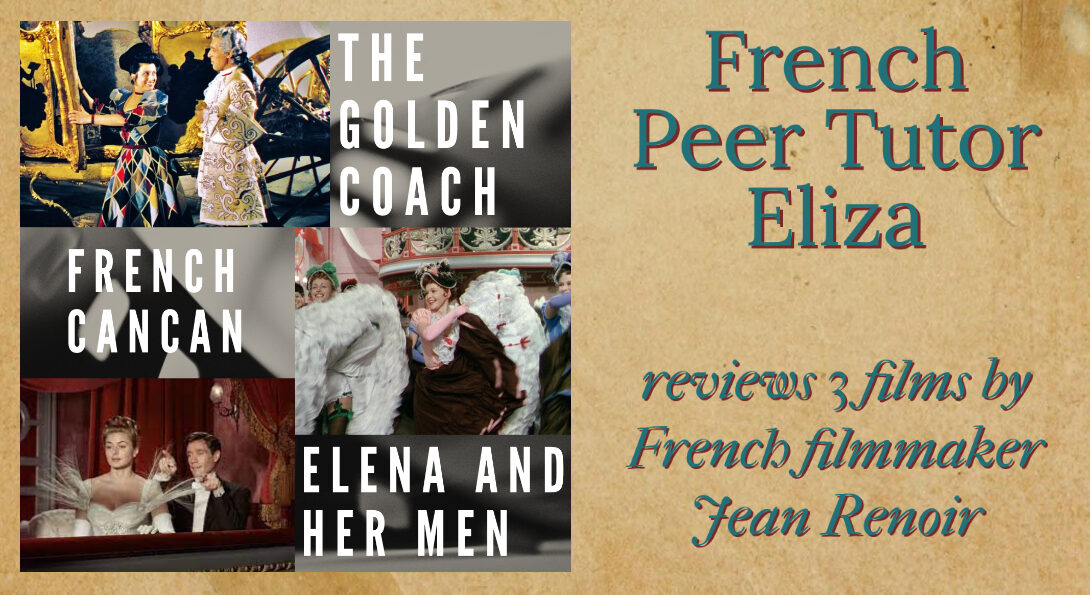3.13.2023: French Peer Tutor Eliza reviews 3 films by French filmmaker Jean Renoir

French Peer Tutor Eliza reviews 3 films by French filmmaker Jean Renoir Heading link
If you’re looking for escapist films, look no further than three films by renowned French filmmaker Jean Renoir: The Golden Coach (1953), French Cancan (1955), and Elena and Her Men (1956). These films, aptly named and packaged by Criterion as “Stage and Spectacle”, are films that enjoy life and love. Though the films are not chronologically related, they each tell intricate, but similar, stories, filled with themes to explore and colorful scenes to enjoy. According to Criterion, “Jean Renoir indulged his lifelong obsession with life-as-theater” in the creation of the films, and this is easily seen in all three.
The first movie Renoir produced is unique compared to the others. The Golden Coach is an English-speaking movie that takes place in 18th-century Peru and centers on an Italian troupe and its interaction with the local population. In this film, Camilla, a member of the troupe, is pursued by three men: Felipe, who travels with the troupe; Ramon, a torreador; and Ferdinand, the viceroy (or as a little boy calls him, “The king!”). Though Felipe is gone for most of the movie and returns at the end in an attempt to claim Camilla and have her join him in the “new world”, there is plenty of drama to go around as Ramon and the viceroy both try to woo Camilla. Something important to note is that the story itself is placed “on the stage” in that the first and last sequence of the film involve a zooming in and zooming out of a theatre stage. It certainly leaves the viewer wondering if Camilla was acting the entire time, or if she really did fall in love with one of the men!
French Cancan, Renoir’s second film of the three, is my favorite. If you aren’t familiar with the musical Moulin Rouge! (2001) by Baz Luhrmann (which I also highly recommend), French Cancan is a great place to start and learn about the famed Montmartre cabaret. A fictionalized account of the beginnings of the Moulin Rouge, French Cancan follows entertainment entrepreneur Henri Danglard and washing-girl-turned-dancer Nini as the two navigate the struggle of opening up the cabaret, balancing separate love lives, and eventually coming together as Nini as Henri’s mistress. Just like The Golden Coach and Camilla, Nini is caught between three men and ultimately decides on the joys of being a performer. Whether or not she ends up with one of her lovers is unclear, but Renoir doesn’t seem to stress this as the main plot of the film, and rather uses the love triangle to further the actual story and cement Renoir’s philosophy on the superiority of the stage. In the film, Nini catches Henri with another girl and Henri uses the moment to deliver a speech in which he says that nothing, including passing love, compares to the success of the stage. The final sequence that follows Henri’s speech is one of my favorite scenes in cinema. We finally see the performance of the new “French Cancan” and it is 10 minutes of breathtaking colors, swooping skirts, and pans of joyful viewers. Overall, this is a very enjoyable movie that once again puts Renoir’s love for the theatre front and center.
The last of the trilogy, Elena and Her Men is no less intriguing than the rest, though its connection to theater is the least obvious. Set in France just before the turn of the 20th century, this film follows Elena, a Polish “princess” who lives in France and needs to marry for money since her family has gone bankrupt, and women of noble status did not work at the time. After agreeing to marry an old family friend, Elena gets lost in the crowds of Bastille Day and meets Count de Chevincourt. They are immediately attracted to each other, but because the Count is good friends with the general Rollan, he introduces them and the general’s advisors realize what a good pairing the two would make for the press and Elena would be able to influence Rollan to become head of the French government.
Elena believes that she can bring luck to the men she cares for, like a power of sorts. She does this by offering them a daisy as a token to remind them that she is thinking of them, though I think there is really a placebo effect taking place; the men choose to believe they can be successful because they think the flower actually brings good luck. Just like in the other films, we see the struggle of the love triangle, along with other side love stories. Unlike the other two, however, the Count and Elena confess their love for each other at the end of the film, and Rollan is seen leaving with his first love interest. This film really hones in on the theme of love and life, with one of my favorite lines at the end of the film that describes this sentiment: “But when it comes to the art of living, you can count on the French”, spoken by the Count. This line captures the essence of all three of these films; Renoir’s love for life, the theater, and all things aesthetic are shown in these films, and Elena and Her Men closes out the trilogy with a view on life worth remembering!